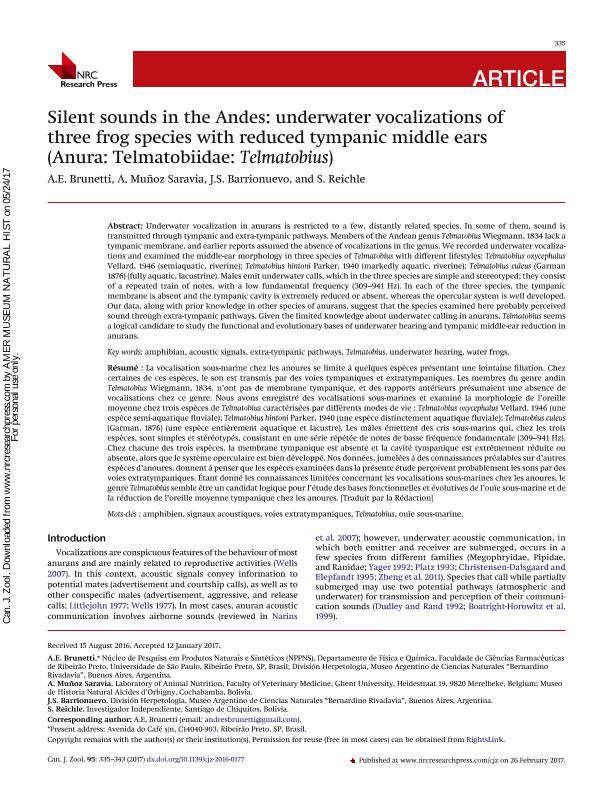Mostrar el registro sencillo del ítem
dc.contributor.author
Brunetti, Andrés Eduardo

dc.contributor.author
Muñoz Saravia, A.
dc.contributor.author
Barrionuevo, Jose Sebastian

dc.contributor.author
Reichle, S.
dc.date.available
2018-06-18T21:03:23Z
dc.date.issued
2017-07
dc.identifier.citation
Brunetti, Andrés Eduardo; Muñoz Saravia, A.; Barrionuevo, Jose Sebastian; Reichle, S.; Silent sounds in the Andes: underwater vocalizations of three frog species with reduced tympanic middle ears (Anura: Telmatobiidae: Telmatobius); National Research Council Canada-NRC Research Press; Canadian Journal of Zoology; 95; 5; 7-2017; 335-343
dc.identifier.issn
0008-4301
dc.identifier.uri
http://hdl.handle.net/11336/49168
dc.description.abstract
Underwater vocalization in anurans is restricted to a few, distantly related species. In some of them, sound is transmitted through tympanic and extra-tympanic pathways. Members of the Andean genus Telmatobius Wiegmann, 1834 lack a tympanic membrane, and earlier reports assumed the absence of vocalizations in the genus. We recorded underwater vocalizations and examined the middle-ear morphology in three species of Telmatobius with different lifestyles: Telmatobius oxycephalus Vellard, 1946 (semiaquatic, riverine); Telmatobius hintoni Parker, 1940 (markedly aquatic, riverine); Telmatobius culeus (Garman 1876) (fully aquatic, lacustrine). Males emit underwater calls, which in the three species are simple and stereotyped; they consist of a repeated train of notes, with a low fundamental frequency (309–941 Hz). In each of the three species, the tympanic membrane is absent and the tympanic cavity is extremely reduced or absent, whereas the opercular system is well developed. Our data, along with prior knowledge in other species of anurans, suggest that the species examined here probably perceived sound through extra-tympanic pathways. Given the limited knowledge about underwater calling in anurans, Telmatobius seems a logical candidate to study the functional and evolutionary bases of underwater hearing and tympanic middle-ear reduction in anurans.
dc.description.abstract
La vocalisation sous-marine chez les anoures se limite a` quelques espèces présentant une lointaine filiation. Chez certaines de ces espèces, le son est transmis par des voies tympaniques et extratympaniques. Les membres du genre andin Telmatobius Wiegmann, 1834, n’ont pas de membrane tympanique, et des rapports antérieurs présumaient une absence de vocalisations chez ce genre. Nous avons enregistré des vocalisations sous-marines et examiné la morphologie de l’oreille moyenne chez trois espèces de Telmatobius caractérisées par différents modes de vie : Telmatobius oxycephalus Vellard, 1946 (une espèce semi-aquatique fluviale); Telmatobius hintoni Parker, 1940 (une espèce distinctement aquatique fluviale); Telmatobius culeus (Garman, 1876) (une espèce entièrement aquatique et lacustre). Les mâles émettent des cris sous-marins qui, chez les trois espèces, sont simples et stéréotypés, consistant en une série répétée de notes de basse fréquence fondamentale (309−941 Hz). Chez chacune des trois espèces, la membrane tympanique est absente et la cavité tympanique est extrêmement réduite ou absente, alors que le système operculaire est bien développé. Nos données, jumelées a` des connaissances préalables sur d’autres espèces d’anoures, donnent a` penser que les espèces examinées dans la présente étude perçoivent probablement les sons par des voies extratympaniques. Étant donné les connaissances limitées concernant les vocalisations sous-marines chez les anoures, le genre Telmatobius semble être un candidat logique pour l’étude des bases fonctionnelles et évolutives de l’ouïe sous-marine et de la réduction de l’oreille moyenne tympanique chez les anoures.
dc.format
application/pdf
dc.language.iso
eng
dc.publisher
National Research Council Canada-NRC Research Press

dc.rights
info:eu-repo/semantics/openAccess
dc.rights.uri
https://creativecommons.org/licenses/by-nc-sa/2.5/ar/
dc.subject
Acoustic Signals
dc.subject
Amphibian
dc.subject
Extra-Tympanic Pathways
dc.subject
Telmatobius
dc.subject
Underwater Hearing
dc.subject
Water Frogs
dc.subject.classification
Otras Ciencias Biológicas

dc.subject.classification
Ciencias Biológicas

dc.subject.classification
CIENCIAS NATURALES Y EXACTAS

dc.title
Silent sounds in the Andes: underwater vocalizations of three frog species with reduced tympanic middle ears (Anura: Telmatobiidae: Telmatobius)
dc.type
info:eu-repo/semantics/article
dc.type
info:ar-repo/semantics/artículo
dc.type
info:eu-repo/semantics/publishedVersion
dc.date.updated
2018-06-04T17:26:45Z
dc.identifier.eissn
1480-3283
dc.journal.volume
95
dc.journal.number
5
dc.journal.pagination
335-343
dc.journal.pais
Canadá

dc.description.fil
Fil: Brunetti, Andrés Eduardo. Universidade de Sao Paulo; Brasil. Consejo Nacional de Investigaciones Científicas y Técnicas. Oficina de Coordinación Administrativa Parque Centenario. Museo Argentino de Ciencias Naturales "Bernardino Rivadavia"; Argentina
dc.description.fil
Fil: Muñoz Saravia, A.. University of Ghent; Bélgica. Museo de Historia Natural Alcides d’Orbigny; Bolivia
dc.description.fil
Fil: Barrionuevo, Jose Sebastian. Consejo Nacional de Investigaciones Científicas y Técnicas. Oficina de Coordinación Administrativa Parque Centenario. Museo Argentino de Ciencias Naturales "Bernardino Rivadavia"; Argentina
dc.description.fil
Fil: Reichle, S.. No especifica;
dc.journal.title
Canadian Journal of Zoology

dc.relation.alternativeid
info:eu-repo/semantics/altIdentifier/doi/https://dx.doi.org/10.1139/cjz-2016-0177
dc.relation.alternativeid
info:eu-repo/semantics/altIdentifier/url/http://www.nrcresearchpress.com/doi/10.1139/cjz-2016-0177#.Wygd1lVKiUk
Archivos asociados
